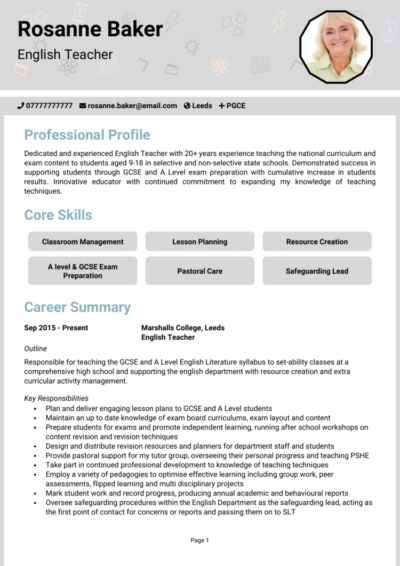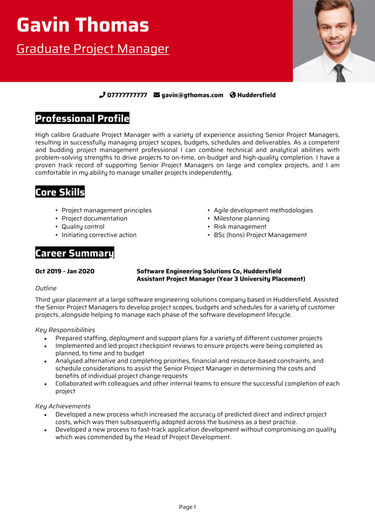Whether you’re guiding students through Shakespeare or syntax, the value you bring to the classroom is rooted in clarity and care. But no matter how well you manage a lesson plan, getting your next teaching role starts with a document far shorter than any novel: your CV.
In this guide, you’ll find an English Teacher CV example and advice designed to help you present your experience and passion in a format that’s as clear and engaging as your best lesson, to land the teaching job you’re after.
English Teacher CV sample
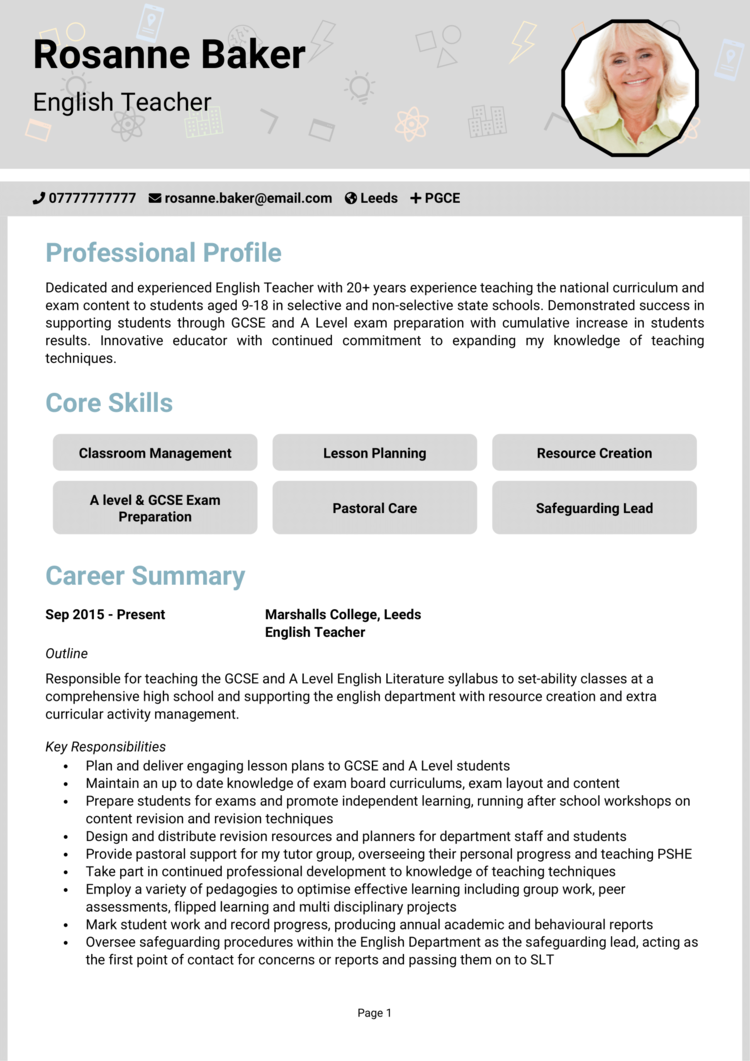
How to write your English Teacher CV
Discover how to craft a winning English Teacher CV that lands interviews with this simple step-by-step guide.
Just like a strong opening chapter draws a reader in, your CV should hook employers from the start. They want to see your passion and the positive impact you’ve made in schools.
This guide will walk you through writing a CV clearly, tailoring it to your subject and school type, and will enable you to highlight the value you bring to students and staff.
What’s the right way to structure and format your English Teacher CV?
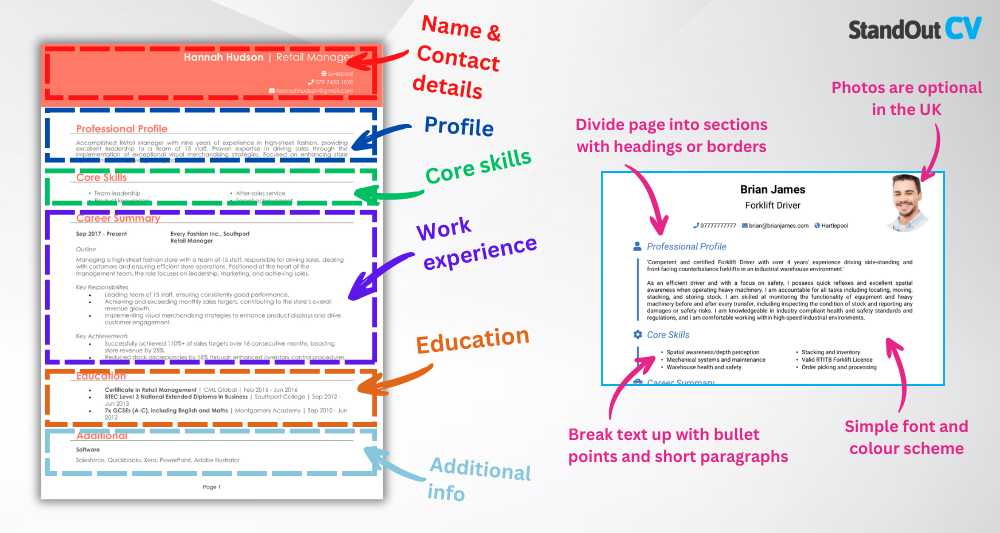
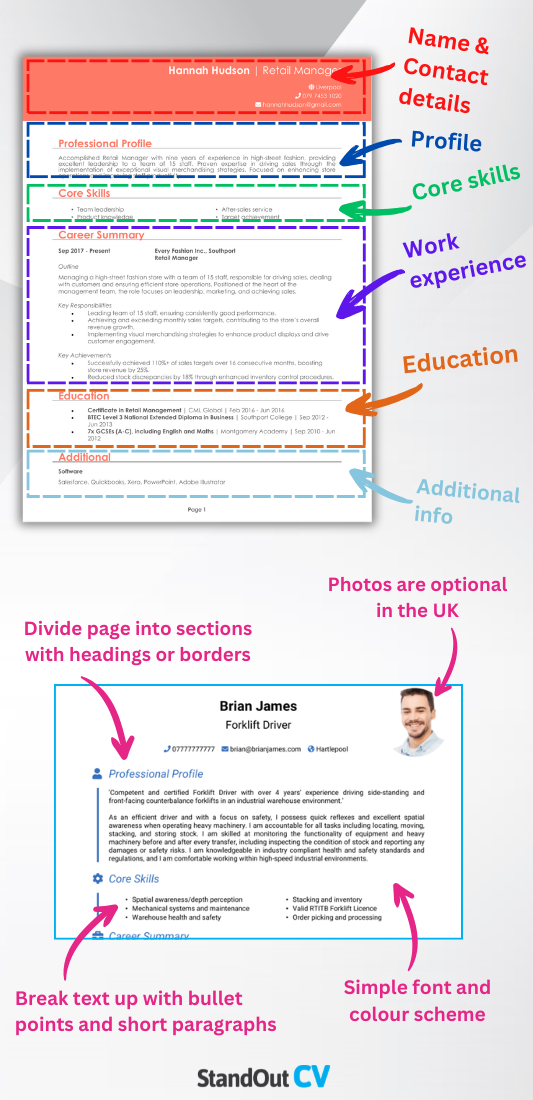
A structured CV shows you know how to present information clearly – something every good English teacher can appreciate. Employers should be able to find your qualifications, experience, and specialisms without digging through dense paragraphs.
Here’s how your CV should be laid out:
- Name and contact details – Keep your name and personal details front and centre at the top. Whether or not to include a photo is your decision.
- Profile – Start with a snapshot of your skills, career highlights, and professional aspirations.
- Core skills – Focus on your most important and tangible strengths, making it easy for employers to see your key strengths at a glance.
- Work experience – Walk through your professional experience, beginning with your latest position and moving backwards.
- Education – Outline your education and certifications, focusing on those most relevant to the role like your degree.
- Additional info – Optionally add any additional details, like awards, professional memberships, or hobbies that highlight your skills or personality.
Use bullet points to break down your responsibilities and achievements clearly – just like you’d advise students to structure their ideas in essays. Divide your format into clearly labelled sections, with a readable font. And finally, keep your CV to a maximum of two pages long – concise enough to hold attention, but detailed enough to demonstrate your strengths in full. Keeping these tips in mind will avoid any distracting visual errors.
How to create an English Teacher CV profile
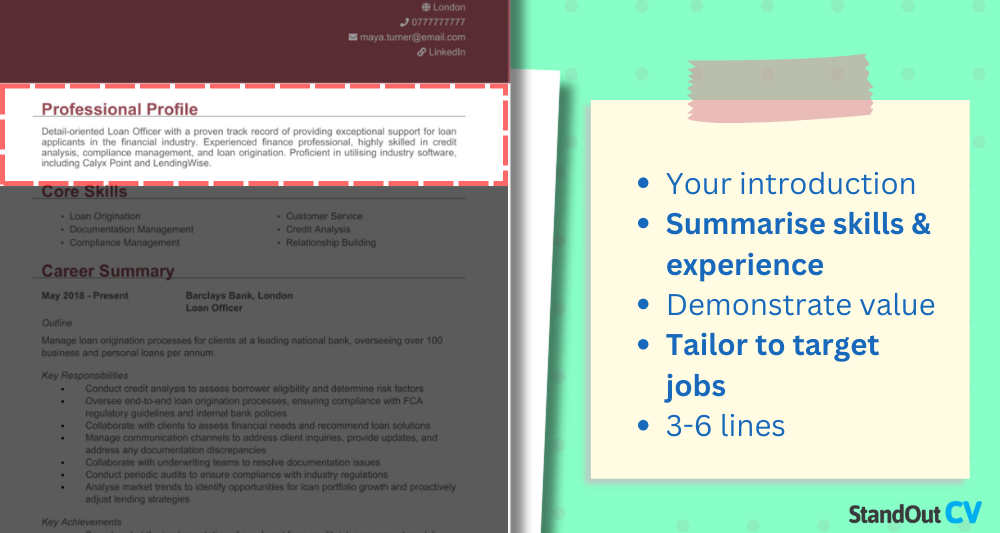
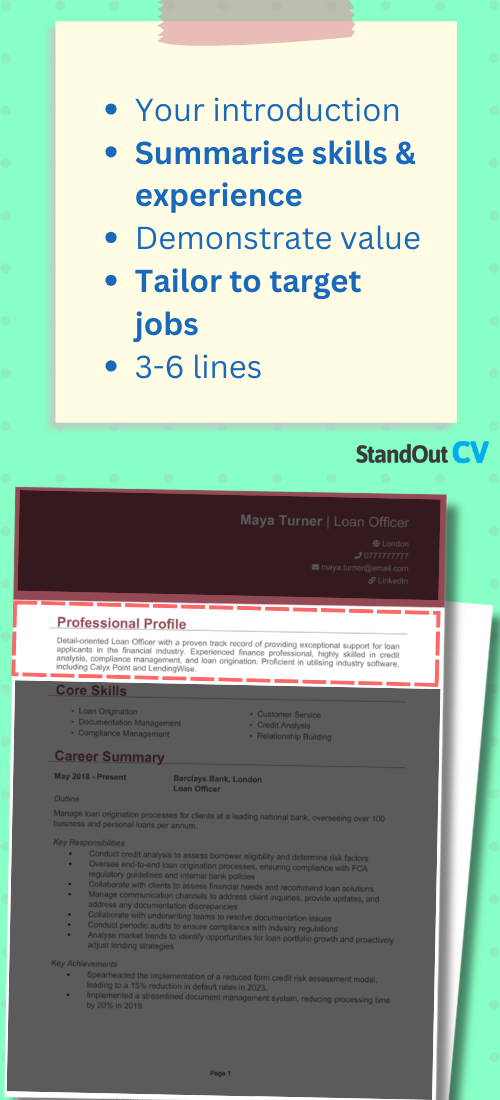
Your CV profile sits at the top of your CV and acts as your personal introduction. It should quickly convey who you are as a teacher, the level and type of experience you have, and the kind of educator you aim to be. Think of it as your teaching ethos in a few short lines – balanced between professional credentials and a clear sense of purpose.
English Teacher CV profile examples
Profile 1
Passionate and dedicated English Teacher with five years of experience delivering engaging lessons in literature and language at secondary level. Skilled in developing differentiated lesson plans, supporting student progress, and preparing pupils for GCSE and A-Level exams. Strong classroom management skills and a commitment to fostering a love of reading and critical thinking in learners.
Profile 2
Creative English Teacher with four years of classroom experience in diverse school settings. Specialises in teaching KS3 and KS4 English, with a focus on improving written communication and analytical skills. Experienced in using assessment data to personalise learning and support pupils of varying abilities. Known for encouraging independent thought and high academic expectations.
Profile 3
Experienced English Teacher with six years of success improving student outcomes in both language and literature. Proficient in curriculum development, exam preparation, and integrating technology to enhance engagement. Adept at building strong relationships with students and parents to support academic and personal development. Committed to inclusive education and lifelong learning.
Details to put in your English Teacher CV profile
Here’s what to include:
- Where you’ve worked – Mention the types of schools you’ve taught in – primary, secondary, academy, international, etc.
- Your top qualifications – Highlight your PGCE, QTS, and English-related degree(s).
- Essential skills – Include strengths such as curriculum planning, classroom management, and differentiation.
- Experience preparing students for assessments – E.g. GCSEs, A-Levels, or international qualifications.
- Literacy intervention or pastoral support work – Mention any broader contributions you’ve made to student wellbeing or literacy development.
Presenting your core skills
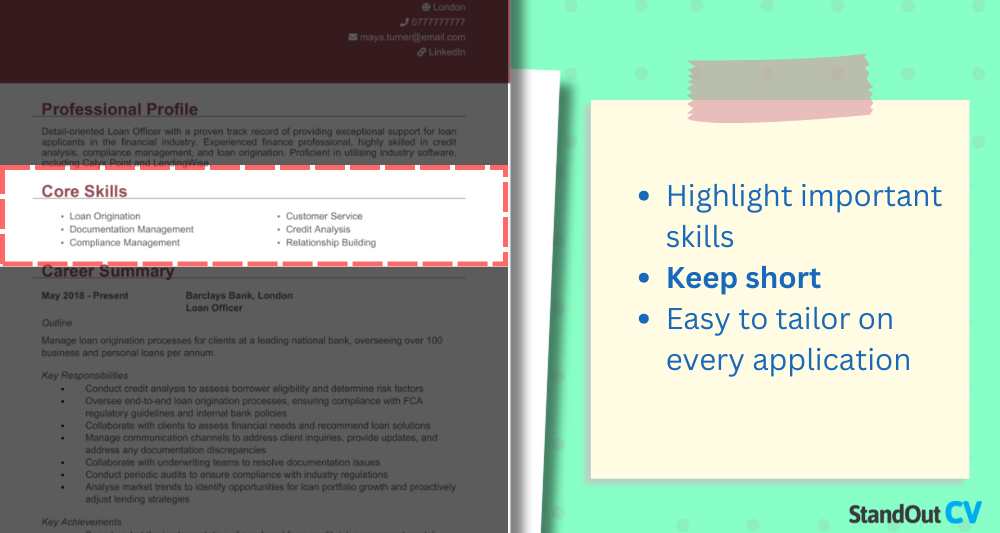

This section should be a greatest hits list – what you bring to the classroom and why it matters. Highlight skills that help students succeed – and help departments run smoothly. Your CV skills should be tailored to each application by matching it to the job advert and the school’s priorities.
You might include areas such as KS3/KS4 delivery, creative writing instruction, EAL support, exam preparation, SEN differentiation, or using data to track progress. Keep the list sharp and relevant.
Essential skills that recruiters look for in an English Teacher CV
- Curriculum and Lesson Planning – Designing engaging lessons aligned with national curriculum standards and learning objectives.
- Literature and Language Instruction – Teaching grammar, vocabulary, reading comprehension, creative writing, and literary analysis.
- Student Assessment and Feedback – Creating and marking tests, essays, and assignments to evaluate progress and provide constructive feedback.
- Classroom Management – Establishing a positive and focused learning environment through clear expectations and behavioural strategies.
- Differentiated Instruction – Adapting teaching methods to accommodate varying learning styles and abilities.
- Exam Preparation – Supporting students with revision techniques and targeted practice for exams like GCSEs, A-Levels, or international equivalents.
- Critical Thinking and Discussion Facilitation – Encouraging students to analyse texts, form arguments, and express ideas through debate and discussion.
- Technology Integration – Using digital tools, online resources, and virtual platforms to enhance learning and engagement.
- Parental Communication – Providing updates on student progress and working collaboratively with parents to support learning.
- Professional Development – Participating in training and staying current with educational trends, pedagogical methods, and curriculum updates.
How to highlight work experience
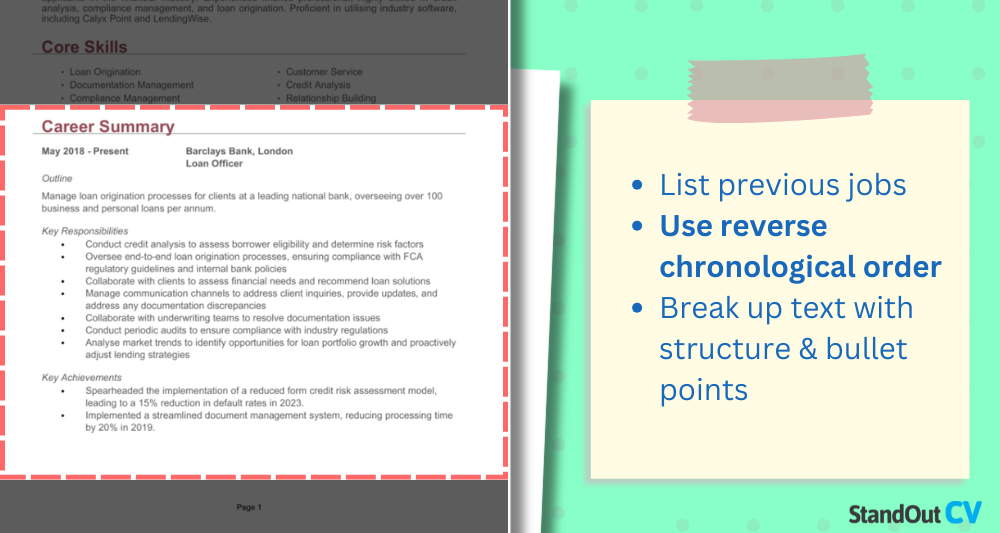
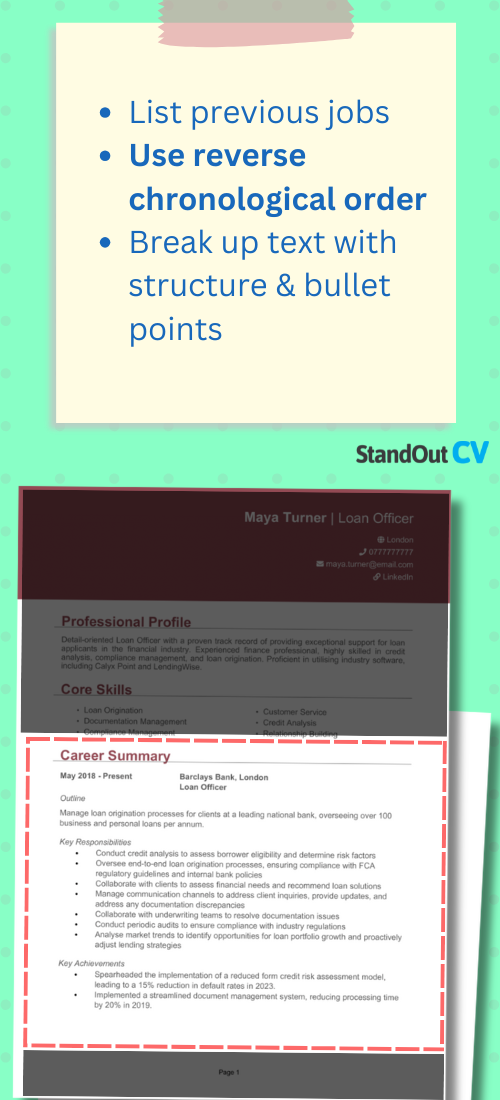
Your work experience section should give a clear picture of your teaching journey so far. From lesson delivery and marking to whole-school initiatives and parent communication, show how you’ve contributed to learning environments and supported pupil progress.
List your roles from most recent to oldest, including job title, school name, and dates. Use bullet points to break down each role into your key responsibilities and successes – especially if they relate to exam outcomes or engagement strategies.
How to make your past experience easy to read for employers
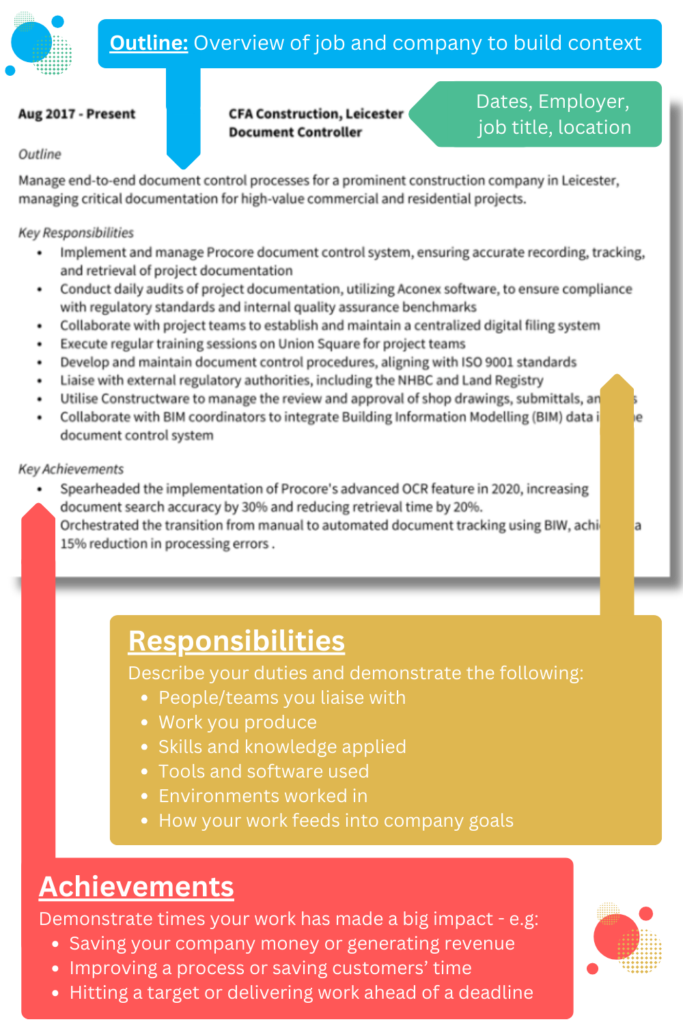
- Outline – Introduce the school, year groups taught, and your teaching role.
- Responsibilities – Use action words like “delivered,” “designed,” “assessed,” or “differentiated.”
- Achievements – Highlight measurable outcomes, such as improved exam results, literacy gains, or Ofsted feedback.
Example job entries for English Teachers
English Teacher | Southhill Secondary School
Outline
Taught English Language and Literature to students aged 11–16 in a large state secondary school, with a focus on GCSE exam preparation and differentiated instruction.
Responsibilities
- Planned and delivered engaging lessons aligned with the national curriculum.
- Prepared students for English Language and Literature GCSEs with targeted interventions.
- Assessed student progress using formative and summative tools, tracking attainment over time.
- Supported SEN and EAL pupils with tailored resources and adapted learning strategies.
- Organised extra-curricular activities including reading clubs and writing competitions.
Achievements
- Increased Year 11 pass rates in English Language by 18% year-on-year.
- Recognised for innovative teaching methods and positive classroom culture.
- Led department CPD session on integrating digital tools into literature teaching.
English Teacher | Elmbrook Academy
Outline
Delivered high-quality English instruction to KS3 and KS4 students at a mixed-ability academy, supporting literacy development and exam readiness.
Responsibilities
- Created lesson plans focusing on key literary texts, grammar, and persuasive writing techniques.
- Facilitated peer assessment and guided group work to improve collaborative learning.
- Incorporated diverse texts to promote inclusivity and critical discussion.
- Contributed to the English department’s long-term curriculum planning.
- Liaised with parents and guardians to support student progress and wellbeing.
Achievements
- Helped 90% of Year 10 students meet or exceed progress targets.
- Improved student engagement through creative writing initiatives and thematic projects.
- Selected to mentor a newly qualified teacher through their induction year.
English Teacher | Norwyn School for Girls
Outline
Taught English Literature and Language to GCSE and A-Level students at a single-sex secondary school with a strong academic ethos.
Responsibilities
- Delivered challenging lessons on poetry, prose, and drama texts including Shakespeare and modern novels.
- Prepared students for written exams and coursework components through structured practice.
- Marked assessments in line with exam board criteria and provided targeted feedback.
- Organised revision workshops and one-on-one tutoring for high-achieving students.
- Participated in whole-school literacy initiatives and enrichment events.
Achievements
- Achieved 100% A–C pass rate in English Literature A-Level in 2023.
- Developed new KS5 resources adopted across the English department.
- Praised by SLT for consistently outstanding lesson observations and pupil outcomes.
Education and qualifications
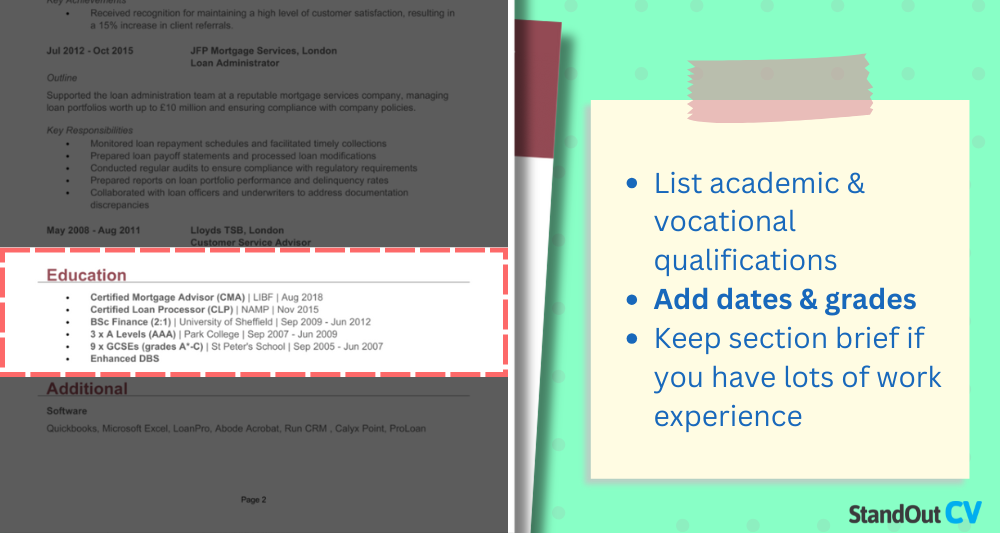

A strong academic and training background is vital for teaching roles. Use this section to list your degrees (especially in English or Literature), teacher training, and QTS or equivalent education.
Start with the most recent and relevant. You can also include safeguarding training, literacy CPD, or exam board assessor experience if applicable. Make sure you keep the focus on your work experience, as recruiters value it more highly.
Qualifications recruiters look for in an English Teacher
- PGCE in Secondary Education (English) – The standard qualification for English teaching.
- Qualified Teacher Status (QTS) – Required for state-funded schools in England.
- BA or MA in English, Literature, or Education – Strong academic background in your subject.
- Level 2 Safeguarding or Prevent Training – Essential for child protection compliance.
- AQA/Edexcel Examiner Training – Demonstrates in-depth understanding of exam standards.


